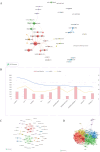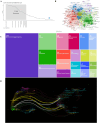Bibliometric and visualization analysis of temporomandibular joint osteoarthritis from 2004 to 2024
- PMID: 40519811
- PMCID: PMC12162900
- DOI: 10.3389/froh.2025.1596551
Bibliometric and visualization analysis of temporomandibular joint osteoarthritis from 2004 to 2024
Abstract
Background: Temporomandibular joint osteoarthritis (TMJOA) is a severe condition affecting the temporomandibular joint, impairing essential oral functions such as chewing, speaking, and swallowing. Recent studies have made significant outcomes in pathogenesis, clinical symptoms, and therapy in the field of TMJOA. However, knowledge of research trends and hotspots of TMJOA is still lacking in this field. This study conducted a bibliometric analysis of TMJOA, providing a comprehensive overview of current research hotspots and trends.
Methods: A total of 584 TMJOA-related records published between 2004 and 2024 were retrieved from the Web of Science Core Collection (WoSCC) database. VOSviewer, CiteSpace, the R package "bibliometrix", and the Bibliometric website were used to analyze countries, institutions, journals, authors, and keywords to identify research trends in TMJOA.
Results: Publications on TMJOA have shown a steady annual increase. Globally, China and the USA emerged as the leading contributors, accounting for over 60% of the publications. Sichuan University ranked first in total publications and citations, while the University of Northern Carolina led in average citations. The Journal of Oral Rehabilitation published the most studies, whereas the Journal of Dental Research had the highest impact factor (5.3) and H-index (158). Long X was the most prolific author, while Liu Y, Manfredini D, and Guarda-Narnini L were the top-cited authors with the highest H-indices. Keyword analysis revealed four primary research clusters: "pathogenesis mechanisms", "clinical manifestations", "regeneration research", and "therapy research".
Conclusion: This bibliometric analysis highlights publication trends, research hotspots, citation patterns, and collaborative networks among countries, institutions, and authors in the TMJOA field. Future research is expected to focus on molecular signaling pathways and targeted therapies for TMJOA, with the ultimate goal of accelerating translational research to enhance clinical outcomes for patients.
Keywords: CiteSpace; VOSviewer; bibliometric; osteoarthritis; temporomandibular joint.
© 2025 Xu, Yu, Wang and Gao.
Conflict of interest statement
The authors declare that the research was conducted in the absence of any commercial or financial relationships that could be construed as a potential conflict of interest.
Figures








Similar articles
-
Bibliometric Analysis of Research on Temporomandibular Joint and Occlusion from 2000 to 2022.J Pain Res. 2023 Aug 16;16:2847-2860. doi: 10.2147/JPR.S418362. eCollection 2023. J Pain Res. 2023. PMID: 37605745 Free PMC article.
-
Tracing global progress: two decades of age-related macular degeneration research.Int J Ophthalmol. 2025 May 18;18(5):925-936. doi: 10.18240/ijo.2025.05.20. eCollection 2025. Int J Ophthalmol. 2025. PMID: 40385108 Free PMC article.
-
Research and publication trends on knee osteoarthritis and cellular senescence: a bibliometric analysis.Front Physiol. 2023 Nov 17;14:1269338. doi: 10.3389/fphys.2023.1269338. eCollection 2023. Front Physiol. 2023. PMID: 38046948 Free PMC article.
-
A bibliometric analysis of the research hotspots and frontiers related to cell death in spinal cord injury.Front Neurol. 2024 Jan 5;14:1280908. doi: 10.3389/fneur.2023.1280908. eCollection 2023. Front Neurol. 2024. PMID: 38249747 Free PMC article.
-
Hotspots and research trends of gut microbiome in polycystic ovary syndrome: a bibliometric analysis (2012-2023).Front Microbiol. 2025 Jan 8;15:1524521. doi: 10.3389/fmicb.2024.1524521. eCollection 2024. Front Microbiol. 2025. PMID: 39845049 Free PMC article.
References
-
- Matsumoto R, Ioi H, Goto TK, Hara A, Nakata S, Nakasima A, et al. Relationship between the unilateral TMJ osteoarthritis/osteoarthrosis, mandibular asymmetry and the EMG activity of the masticatory muscles: a retrospective study. J Oral Rehabil. (2010) 37:85–92. 10.1111/j.1365-2842.2009.02026.x - DOI - PubMed
Publication types
LinkOut - more resources
Full Text Sources

